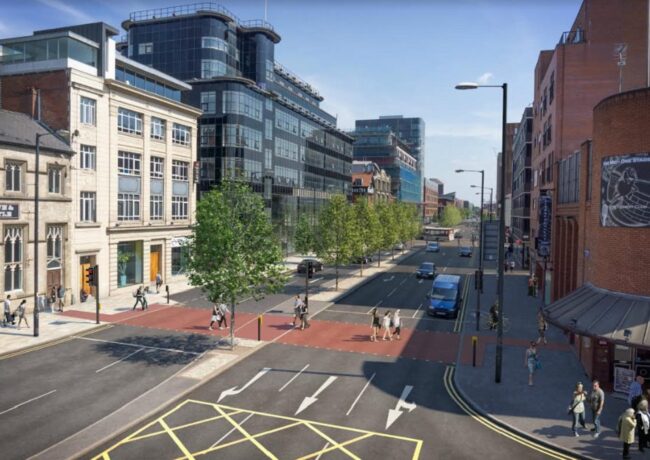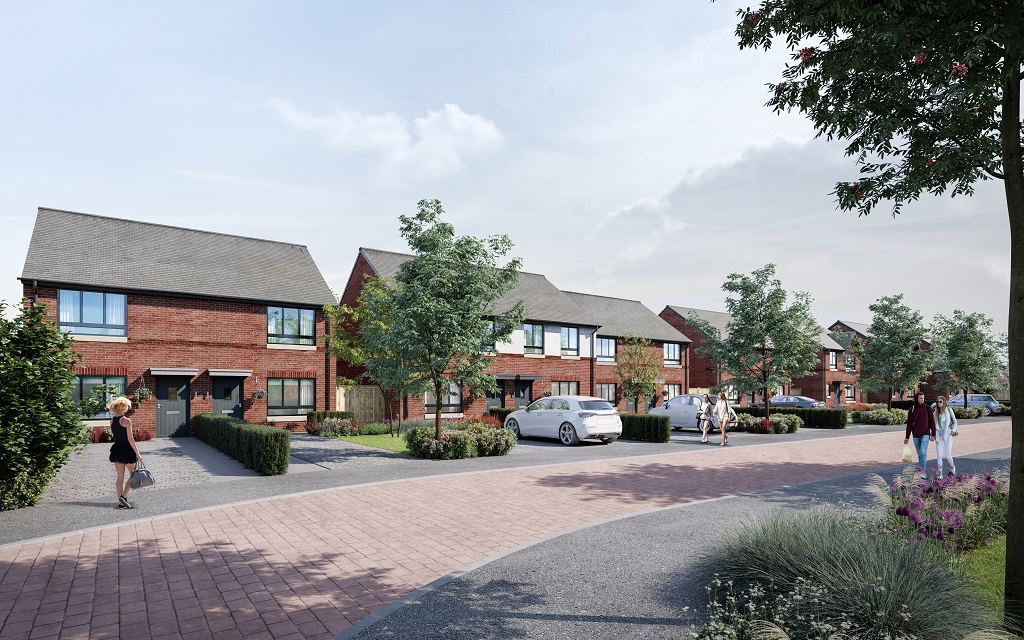Work starts on Great Ancoats Street
A £9.1m scheme to improve Great Ancoats Street in Manchester city centre has started today.
The project, which is scheduled to take 12 months, is one of several designed to provide long-term improvements to Manchester’s travel infrastructure.
Once complete, it will include new crossing facilities, more than 70 trees, wider pavements, redesigned, clearer signage, and parallel cycle lanes.
Great Ancoats Street is part of the city’s Inner Ring Road and averages more than 37,000 vehicle journeys per day but a spokesperson from Manchester City Council said the newly designed road “does not create extra capacity for traffic”.
The work will take place in phases, between Oldham Road at the junction with Marshall Street and Cornell Street, and along Great Ancoats Street as far as the Metrolink stop at Pollard Street.
Funding for the scheme is made up of £8.8m from the Greater Manchester Growth Deal fund, plus an additional £300,000 for tree planting from the Manchester Salford Inner Relief Route Regent Road Growth Deal scheme.
The first phase will involve a lane closure either side of the existing island on Oldham Road near the junction of Great Ancoats Street. Traffic flow will be maintained in both directions and diversions are not required. This phase is due to start today and will run until mid-February.
The lead contractor on the project is Colas.
Executive member for the environment, planning and transport, Cllr Angeliki Stogia, said: “This improvement scheme for Great Ancoats Street will deliver a more attractive, tree-lined route, with wider pavements and better crossings allowing pedestrians and people on bikes to cross the busy inner ring road more safely.
“With two parallel schemes to create dedicated walking and cycling routes also moving forward, this project is part of a bigger push to make our city centre a safer, cleaner space, where walking and cycling are seen as natural travel options for as many people as possible.
“Our traffic plans will keep vehicles out of nearby residential neighbourhoods and provide safer routes for people walking and cycling across the city centre, while making it easier to get to Ancoats and New Islington from the city centre on foot or by bike.”
Other projects to improve infrastructure in Manchester that are set to get underway this year include the £13.4m Chorlton cycleway scheme and work to replace the existing Princess Road and Medlock Street roundabout.





We moved our office from the city centre to Didsbury as traffic was awful, no doubt more will follow suit now.
By Dan
An absolute waste of £9m!
By Acelius
You moved offices because of traffic to somewhere which is also really busy but less central?
By L
Dan, nobody cares about your car-related problems. Please stop posting your boring drivel on every article. There is a lot more to life than cars
By Anonymous
12 months? what an absolute joke
By Anonymous
Trees are great! That is, until the leaves fall, nobody sweeps them up, and the slimy mess makes a slippery road surface, unsafe for cyclists. And then the bird droppings… Not saying it’s a bad idea, just be careful what you wish for.
LL
By Liver lad
@Dan – the answer to congestion is to reduce traffic by getting more people walking and cycling, not building more road capacity – this has the benefit of combating climate change too
By urbanista
@Dan, Some people who insist on driving (or have no alternative) will move out of the city centre. More people will, and already have, changed their commute to public transport and cycling.
By Anonymous
Too many human lanes, needs more lanes for trees.
By daveboi
A European style boulevard ! where in? Albania? This will lead everyone to the old retail park which will soon be a car park rather than a landscaped park.All these parks but none of them with any grass.
By Elephant
@Elephant – laws are borin anyway
By daveboi
As someone who cycles along this road most days, I was hopeful a cycle lane could have been included, but it doesn’t look like it(?). Presently there is a very short, token cycle lane marked on the pavement which is regularly blocked by taxis picking up and dropping off at the Travelodge. Potentially an opportunity missed by MCC.
By TTFN
I think this will be a massive improvement when it’s finished. Having spent a few weeks in Barcelona in the summer, I can see what they’re trying to achieve. I live on Great Ancoats Street and every time I walk into town I think how bad the footpaths are. Yes it will be disruptive but unfortunately that’s life. Look at what they did on Regent Road, it was a nightmare for months but now there’s rarely any traffic coming off Mancunian Way and visually it looks so much better! People really enjoy being negative too much these days.
By Scott D
@TTFN in theory there are cycle lines, just parallel so possible not actually on G.Ancoats itself. Seems odd but MCC’s defense recycle lanes is the Bee Line infrastructure that is apparently being built so assume it’s the same thing.
G.Ancoats Street is a patchwork mess; I am not sure this solves it. Potentially it makes it look pretty enough to secure someone to buy the retail park and build an expensive skyscraper on it…
Also, this work was initially poised to happen outside rush hour; is that still the case? This seems to have dropped out of their comms.
By Bee
Looks good but the lack of cycle lanes is a staggering oversight.
By Monty
Schemes like this need to happen in Manchester. It might seem like a massive waste of money to a lot of people, particularly motor heads, but the overall impact of a number of the schemes together can have a massive impact on how a city functions.
I’m glad MCC are pushing ahead and willing to experiment with schemes like this as it will eventually help Manchester grow in ways that other cities can’t.
I do think the park would have been a good addition to a wider green infrastructure network as Elephant suggested.
By L
There’s a reason people don’t cycle, we have horrible weather, cycle lanes are pointless in the UK.
By YS
@YS So do the likes of the Netherlands but that doesn’t stop them. I believe they use ‘raincoats’. And if the weather’s really that bad get on a bus or a train or a tram. Cars don’t belong in cities.
By Matt C
I would rather get to work on time than have a journey that’s “attractive with trees” I can have that view out of the city center, absolutely ridiculous
By Anonymous
The arrogance of car drivers is really quite staggering. City centre residents aren’t allowed to live in a nice environment if it means suburban motorists are slightly inconvenienced. Ban all cars I say, they bring out the absolute worst in people
By Anonymous
@ Anonymous…ridiculous comment! Maybe the residents surrounding Great Ancoats St would like a more attractive environment. So no trees, just because you want to use your petrol guzzling polluting car to get to work! Anything they do to make it harder for car users gets my vote.
By Steve
Moan, moan, moan. 10 years ago non of these “city centre residents” were even living here. Maybe if the atrocious public transport was sorted first and we had a world class system like the Netherlands do then many of us ‘arrogant’ car drivers wouldn’t use our “petrol guzzling polluting cars” and would commute. Cutbacks on bus services, a tram system that only goes 4 miles west of the city centre and lets not get started on the train service; is it any wonder people use their own cars as a means of transport?
By Greta Gurnberg
People need to get to work, city dwellers should quit moaning or move out
By Dan